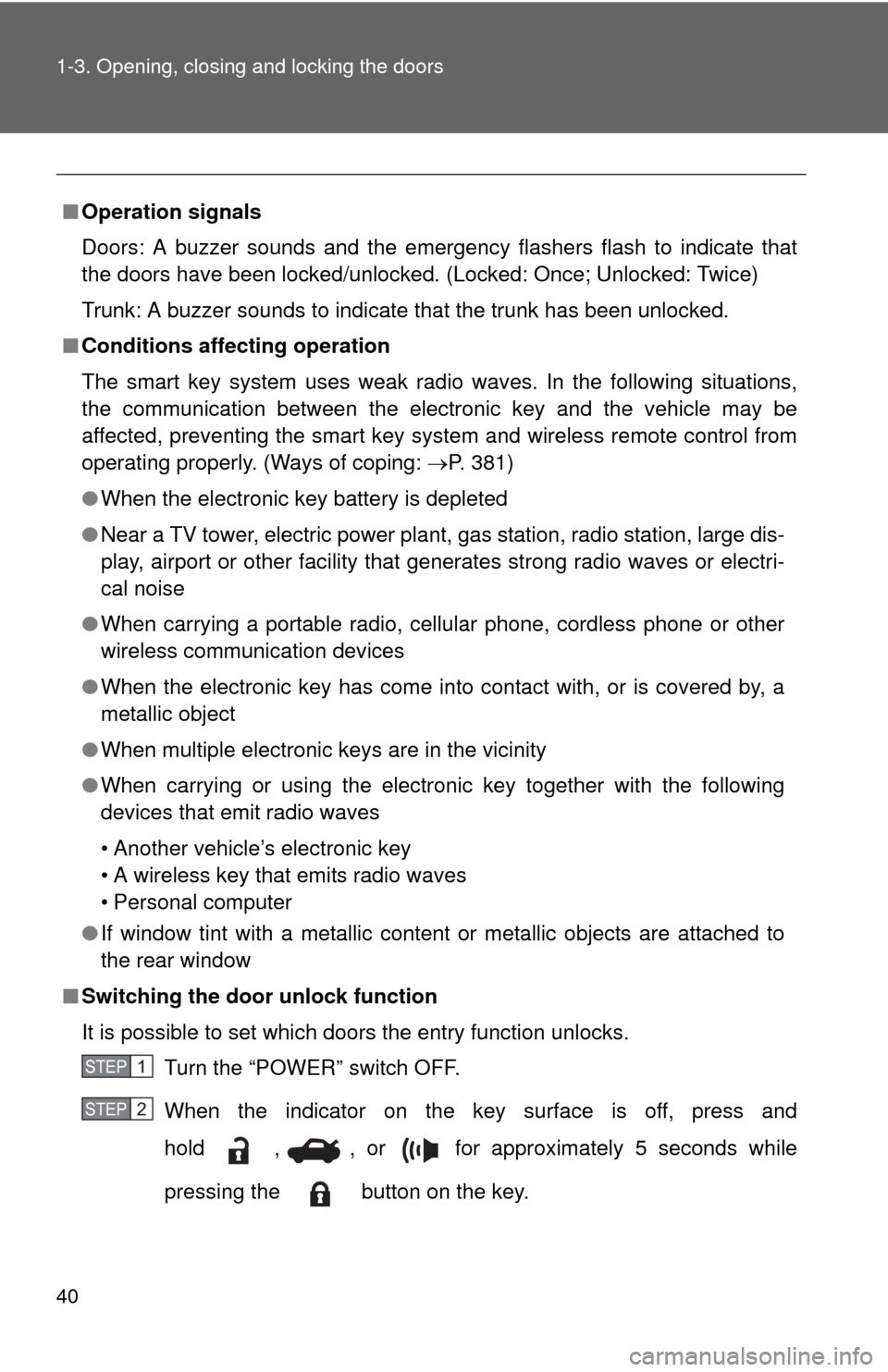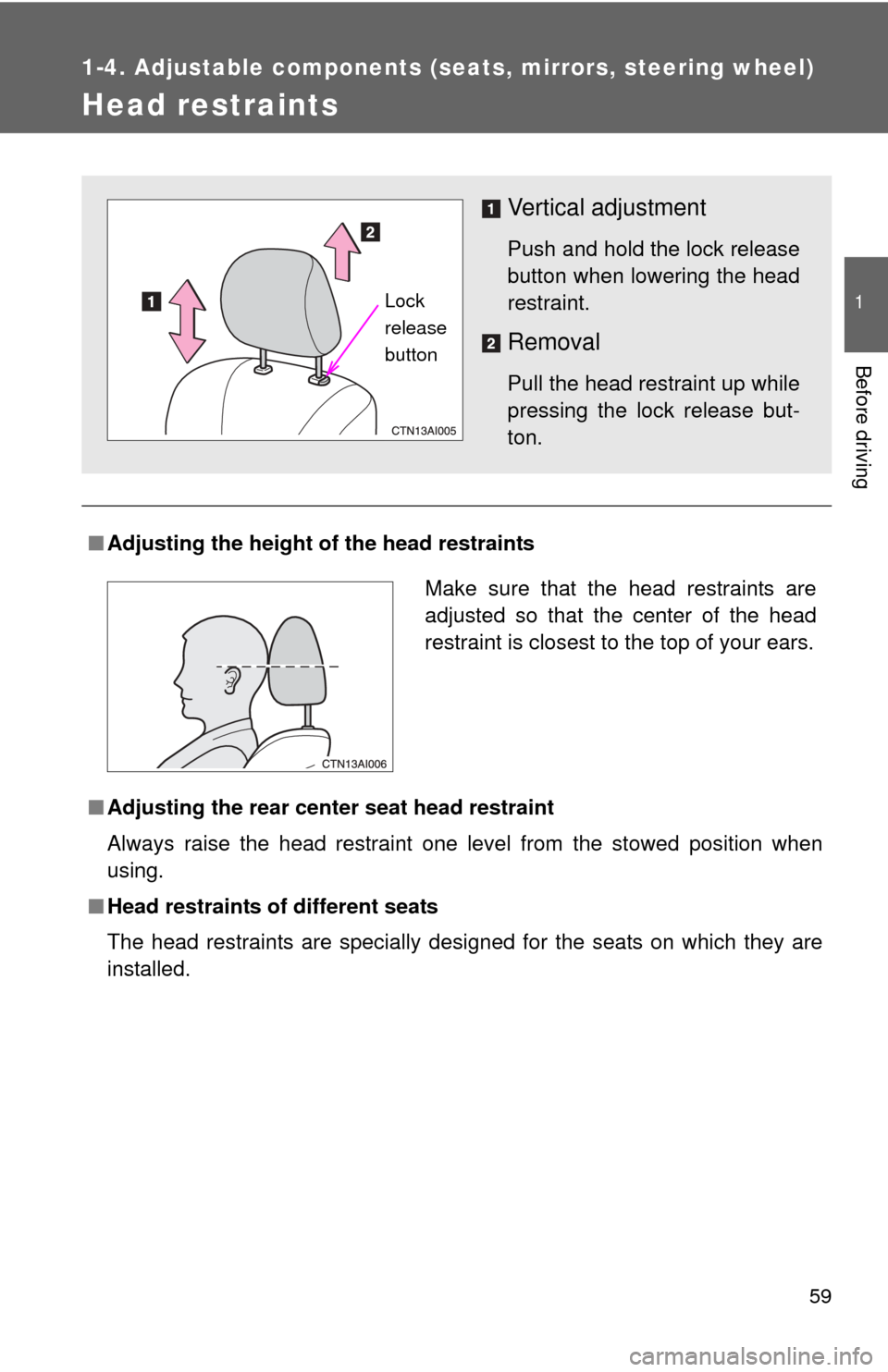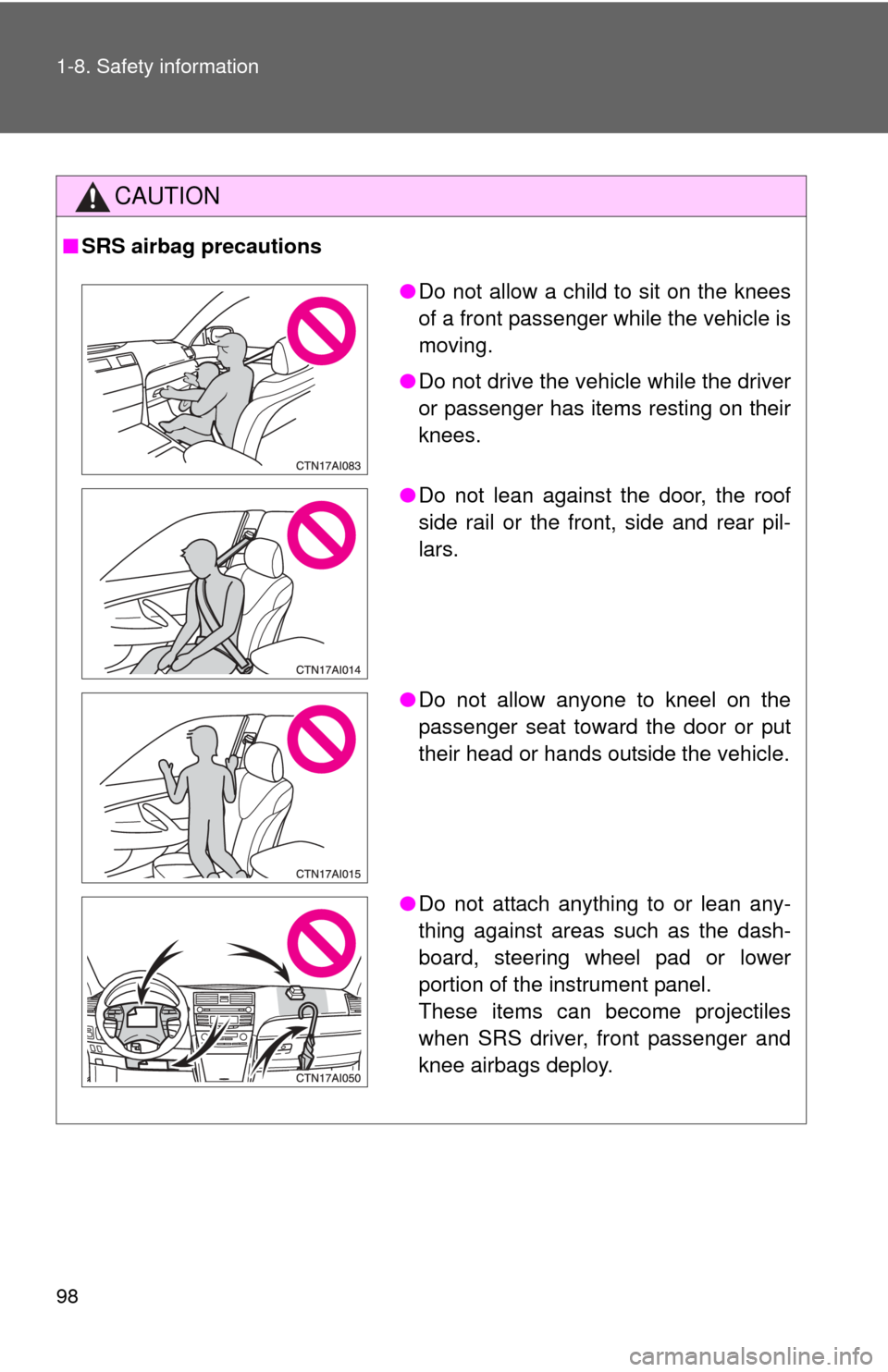2008 TOYOTA CAMRY HYBRID tow
[x] Cancel search: towPage 1 of 440

TABLE OF CONTENTS
1
1Before driving
Information on the hybrid system and adjusting and op-
erating features such as door locks, mirrors, and steer-
ing column.
2When drivingDriving, stopping and safe-driving information.
3Interior fea-
turesAir conditioning and audio systems, as well as other in-
terior features for a comfortable driving experience.
4Maintenance
and careCleaning and protecting your vehicle, performing do-it-
yourself maintenance, and maintenance information.
5When trouble
arisesWhat to do if the vehicle needs to be towed, gets a flat
tire, or is involved in an accident.
6Vehicle
specificationsDetailed vehicle information.
7For U.S.
ownersReporting safety defects for U.S. owners
IndexAlphabetical listing of information contained in this
manual.
Page 3 of 440

1
2
3
4
5
6
7
3
2-4. Using other driving systems ........................... 155
Cruise control ...................... 155
Driving assist systems ........ 158
2-5. Driving information ........... 162 Cargo and luggage ............. 162
Vehicle load limits ............... 165
Winter driving tips ............... 166
Trailer towing ...................... 170
Dinghy towing ..................... 171
3-1. Using the air conditioning system and defogger...... 174
Automatic air conditioning system .............................. 174
Rear window and outside rear view mirror
defoggers .......................... 182
3-2. Using the audio system.... 183 Audio system types ............. 183
Using the radio .................... 186
Using the CD player ............ 192
Playing MP3 and WMA discs ........................ 199
Optimal use of the audio system .............................. 207
Using the AUX adapter ....... 210
Using the steering wheel audio switches .................. 211 3-3. Using the hands-free
phone system (for cellular
phone) ............................. 213
Hands-free phone system (for cellular phone) features
(CD player with changer
only) ................................. 213
Using the hands-free phone system
(for cellular phone) ........... 216
Making a phone call ........... 224
Setting a cellular phone ...... 228
Security and system setup ................................ 233
Using the phone book ........ 237
3-4. Using the interior lights ... 244 Interior lights list ................. 244
• Interior light ...................... 245
• Personal lights.................. 246
3-5. Using the storage features ........................... 247
List of storage features ....... 247
• Glove box ......................... 248
• Console box ..................... 248
• Cup holders ...................... 250
• Auxiliary boxes ................. 251
3-6. Other interior features ..... 253 Sun visors........................... 253
Vanity mirrors ..................... 254
Clock .................................. 255
Ashtrays ............................. 256
Power outlet ....................... 257
Seat heaters ....................... 259
Armrest ............................... 261
Floor mat ............................ 262
3Interior features
Page 4 of 440

TABLE OF CONTENTSIndex
4
Trunk features .................... 263
Garage door opener ........... 264
Compass ............................ 269
4-1. Maintenance and care...... 274 Cleaning and protecting the vehicle exterior ........... 274
Cleaning and protecting the vehicle interior ............ 276
4-2. Maintenance ..................... 279 Maintenance requirements .................... 279
General maintenance ......... 281
Emission inspection and maintenance (I/M)
programs .......................... 284
4-3. Do-it-yourself maintenance ................... 285
Do-it-yourself service precautions ...................... 285
Hood................................... 288
Positioning the jack ............ 289
Engine compartment .......... 291
12-volt battery .................... 300
Tires ................................... 304
Tire inflation pressure......... 313
Wheels ............................... 317
Air conditioning filter ........... 319
Key battery ......................... 322
Checking and replacing fuses ................................ 325
Light bulbs .......................... 336 5-1. Essential information ....... 342
If your vehicle needs to be towed ................................ 342
If you think something is wrong ................................ 345
Event data recorder ............ 346
5-2. Steps to take in an emergency ...................... 348
If a warning light turns on or a warning buzzer
sounds... .......................... 348
If a warning message is displayed .......................... 357
If you have a flat tire ........... 368
If the hybrid system will not start ............................ 377
If the shift lever cannot be shifted from P ................... 379
If you lose your keys ........... 380
If the electronic key does not operate properly ......... 381
If the vehicle’s 12-volt battery is discharged ........ 384
If your vehicle overheats..... 388
If the vehicle becomes stuck ................................. 392
4Maintenance and care
5When trouble arises
Page 32 of 440

32 1-1. Hybrid system
CAUTION
■Road accident cautions
Observe the following precautions to reduce the risk of injury.
●Pull your vehicle off the road, put the shift lever in P, apply the parking
brake, and turn the hybrid system off.
● Do not touch the high voltage parts, cables and connectors.
● If electric wires are exposed inside or outside your vehicle, an electric
shock may occur. Never touch exposed electric wires.
● If a fluid leak occurs, do not touch it as it may be strong alkaline electrolyte
from the hybrid battery (traction battery). If it comes into contact with your
skin or eyes, wash it off immediately with a large amount of water or if pos-
sible, boric acid solution. Seek immediate medical attention.
● If a fire occurs in the hybrid vehicle, leave the vehicle as soon as possible.
Never use a fire extinguisher that is not meant for electric fires. Using even
a small amount of water may be dangerous.
● If your vehicle needs to be towed, do so with the front wheels raised. If the
wheels with the electric motor (traction motor) are on the ground when
towing, the motor may continue to generate electricity. This may cause an
electricity leakage leading to a fire. (
P. 342)
■ Nickel-metal hydride battery
Your vehicle contains a sealed nickel- metal hydride battery. If disposed of
improperly, it is hazardous to the environment and there is a risk of severe
burns and electrical shock that may result in death or serious injury.
■ If the system activates
●Carefully check to see if there are exposed high voltage parts or cables.
Never touch the parts or cables. (
P. 25)
● Carefully inspect the ground under the vehicle. If you find that liquid has
leaked onto the ground, the fuel system may have been damaged. Leave
the vehicle as soon as possible.
Page 40 of 440

40 1-3. Opening, closing and locking the doors
■Operation signals
Doors: A buzzer sounds and the emergency flashers flash to indicate that
the doors have been locked/unlocked. (Locked: Once; Unlocked: Twice)
Trunk: A buzzer sounds to indicate that the trunk has been unlocked.
■ Conditions affecting operation
The smart key system uses weak radio waves. In the following situations,
the communication between the electronic key and the vehicle may be
affected, preventing the smart key system and wireless remote control from
operating properly. (Ways of coping: P. 381)
● When the electronic key battery is depleted
● Near a TV tower, electric power plant, gas station, radio station, large dis-
play, airport or other facility that generates strong radio waves or electri-
cal noise
● When carrying a portable radio, ce llular phone, cordless phone or other
wireless communication devices
● When the electronic key has come into contact with, or is covered by, a
metallic object
● When multiple electronic keys are in the vicinity
● When carrying or using the electronic key together with the following
devices that emit radio waves
• Another vehicle’s electronic key
• A wireless key that emits radio waves
• Personal computer
● If window tint with a metallic content or metallic objects are attached to
the rear window
■ Switching the door unlock function
It is possible to set which doors the entry function unlocks.
Turn the “POWER” switch OFF.
When the indicator on the key surface is off, press and
hold , , or for approximately 5 seconds while
pressing the button on the key.
STEP1
STEP2
Page 59 of 440

59
1
1-4. Adjustable components (seats, mirrors, steering wheel)
Before driving
Head restraints
■Adjusting the height of the head restraints
■ Adjusting the rear cent er seat head restraint
Always raise the head restraint one level from the stowed position when
using.
■ Head restraints of different seats
The head restraints are specially designed for the seats on which they are
installed.
Vertical adjustment
Push and hold the lock release
button when lowering the head
restraint.
Removal
Pull the head restraint up while
pressing the lock release but-
ton.
Lock
release
button
Make sure that the head restraints are
adjusted so that the center of the head
restraint is closest to the top of your ears.
Page 96 of 440

96 1-8. Safety information
CAUTION
■SRS airbag precautions
Observe the following precautions regarding the airbags.
Failure to do so may cause death or serious injury.
●The driver and all passengers in the vehicle must wear their seat belts
properly.
The SRS airbags are supplemental devices to be used with the seat belts.
● The SRS driver airbag deploys with considerable force, and can cause
death or serious injury especially if the driver is very close to the airbag.
The National Highway Traffic Safety Administration (“NHTSA”) advises:
Since the risk zone for the driver’s airbag is the first 2 - 3 in. (50 - 75 mm)
of inflation, placing yourself 10 in. (250 mm) from your driver airbag pro-
vides you with a clear margin of safety. This distance is measured from the
center of the steering wheel to your breastbone. If you sit less than 10 in.
(250 mm) away now, you can change your driving position in several
ways:
• Move your seat to the rear as far as you can while still reaching the pedals comfortably.
• Slightly recline the back of the seat. Although vehicle designs vary, many drivers can achieve the 10 in.
(250 mm) distance, even with the driver seat all the way forward, sim-
ply by reclining the back of the seat somewhat. If reclining the back of
your seat makes it hard to see the road, raise yourself by using a firm,
non-slippery cushion, or raise the seat if your vehicle has that feature\
.
• If your steering wheel is adjustable, tilt it downward. This points the air- bag toward your chest instead of your head and neck.
The seat should be adjusted as recommended by NHTSA above, while
still maintaining control of the foot pedals, steering wheel, and your view of
the instrument panel controls.
Page 98 of 440

98 1-8. Safety information
CAUTION
■SRS airbag precautions
●Do not allow a child to sit on the knees
of a front passenger while the vehicle is
moving.
● Do not drive the vehicle while the driver
or passenger has items resting on their
knees.
● Do not lean against the door, the roof
side rail or the front, side and rear pil-
lars.
● Do not allow anyone to kneel on the
passenger seat toward the door or put
their head or hands outside the vehicle.
● Do not attach anything to or lean any-
thing against areas such as the dash-
board, steering wheel pad or lower
portion of the instrument panel.
These items can become projectiles
when SRS driver, front passenger and
knee airbags deploy.